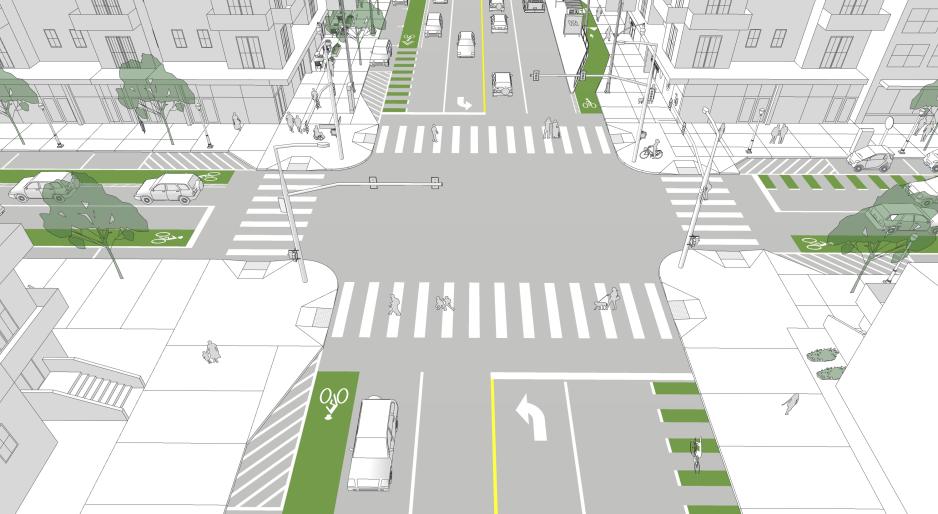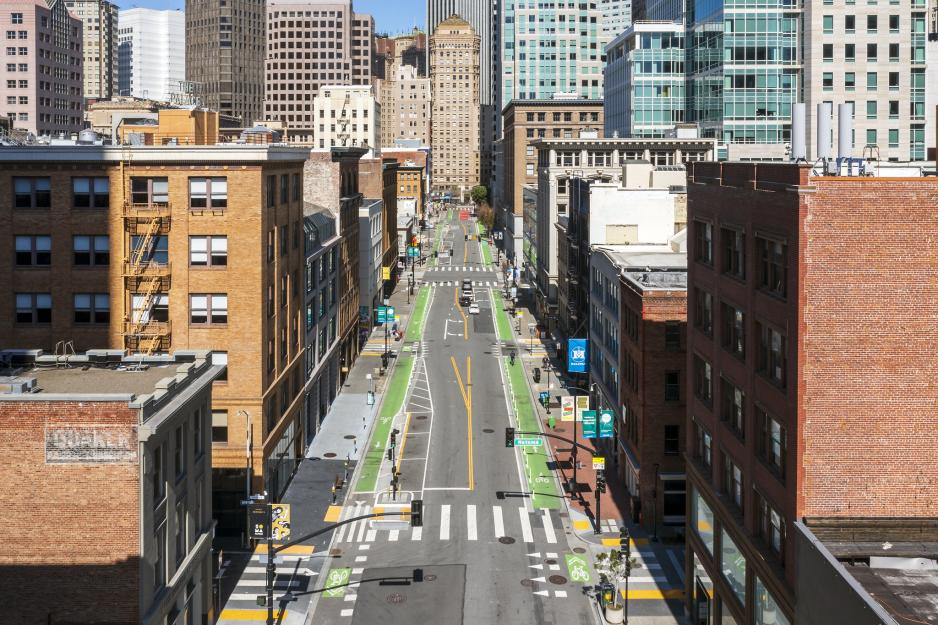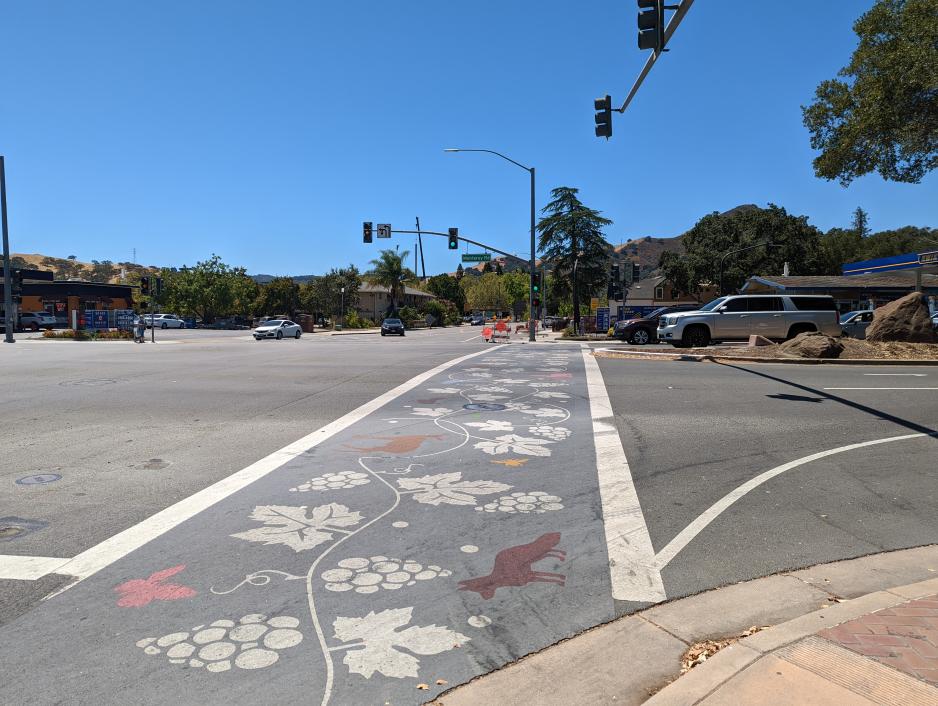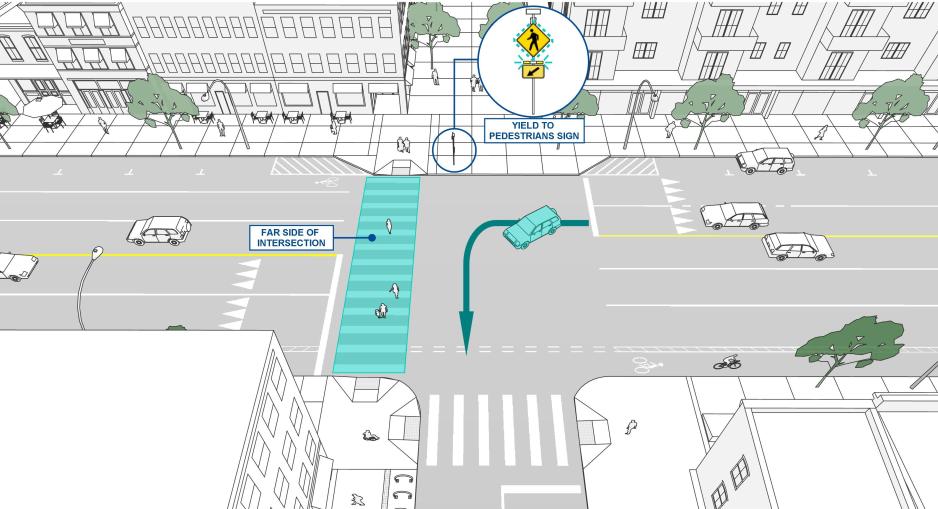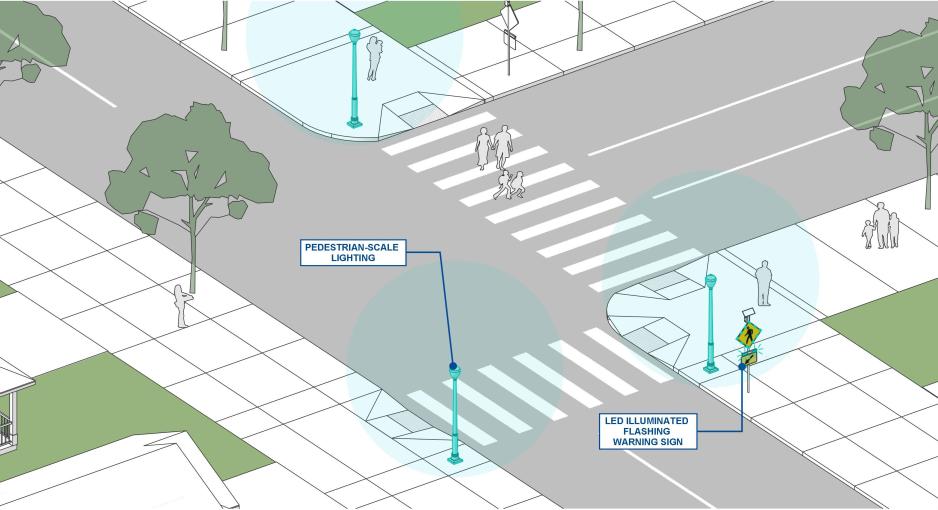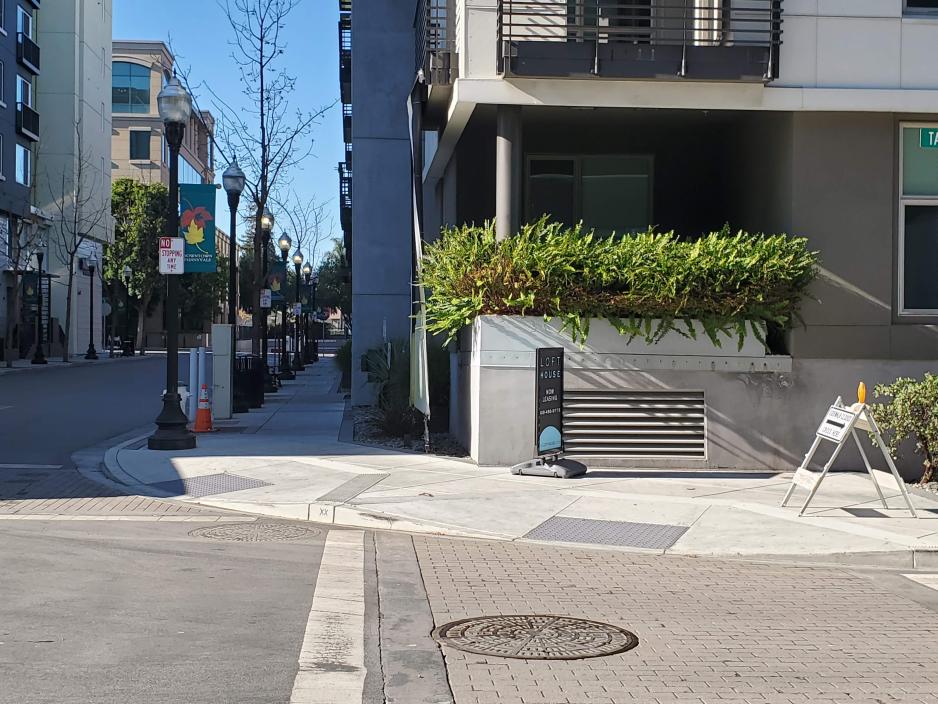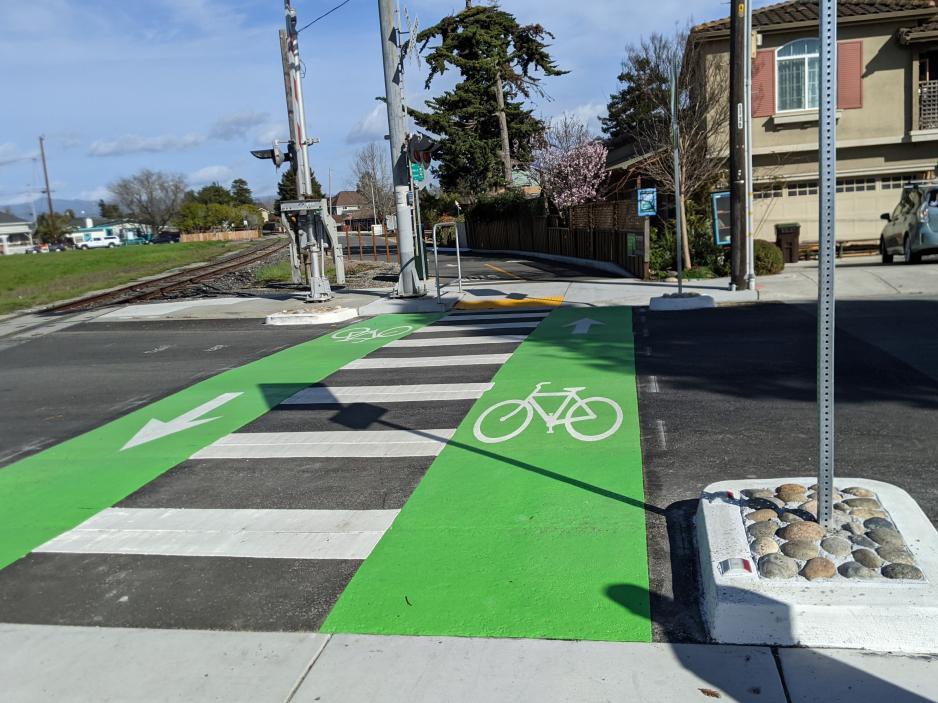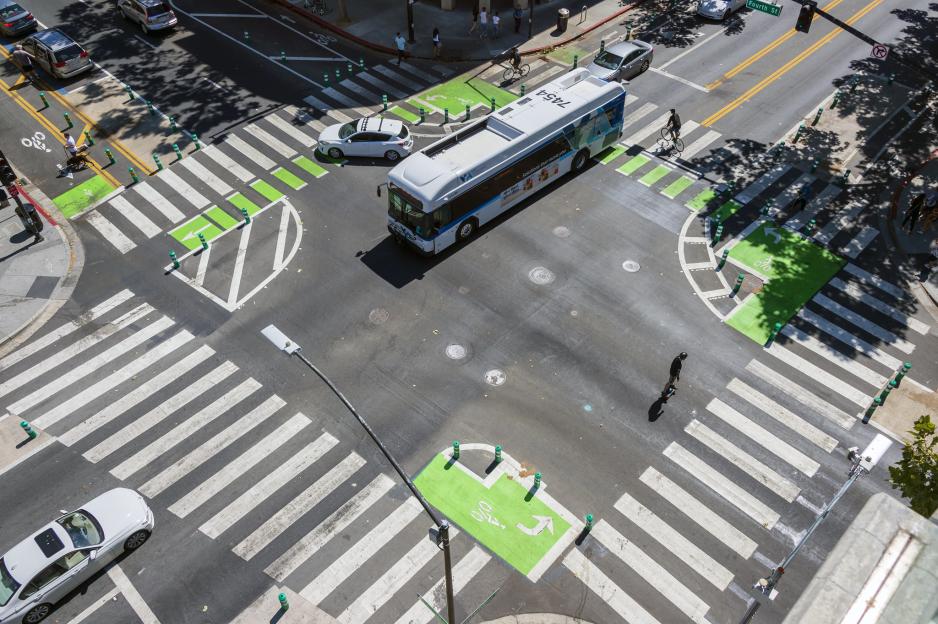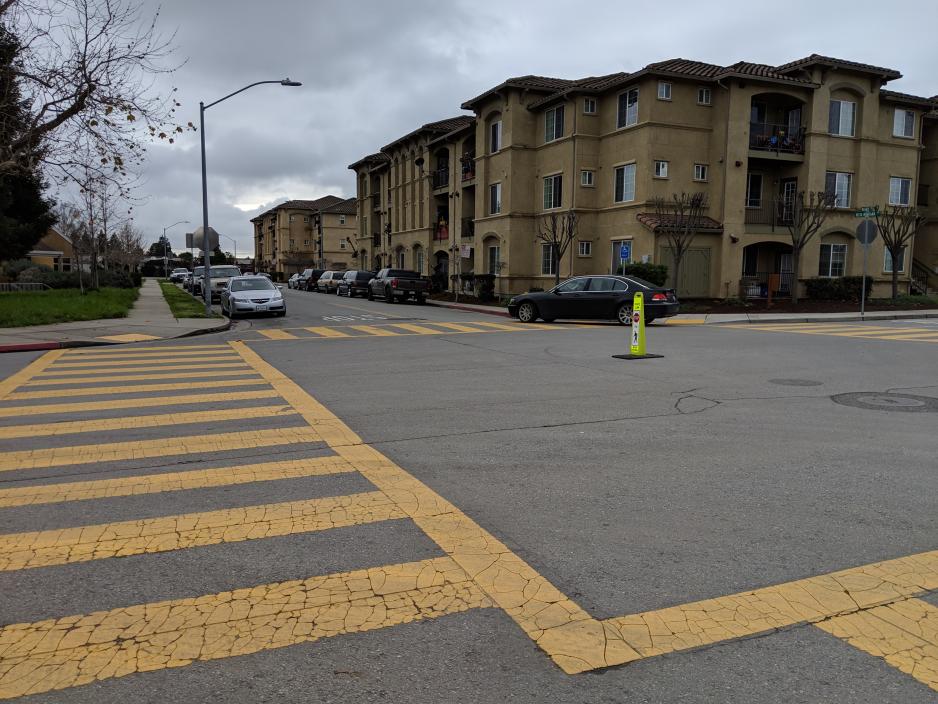Intersections are the point where paths cross, where all modes of travel share the same space, often at the same time. With recent legislation eliminating vehicle level of service as an environmental impact that must be mitigated in California, cities have more flexibility to design intersections to meet goals other than prioritizing automobile travel. Instead, intersections can be designed or redesigned to better accommodate all modes of travel.
Minimize conflict points and shorten crossing distances.
- Reduce the number of motor vehicle lanes pedestrians and bicyclists must cross. If the intersection legs are wide because of right-turn lanes with wide turn radii, consider first whether having right-turn lanes or reducing crossing distances are more desirable in this location.
- Construct raised medians, pedestrian refuge islands, curb extensions or reduce turning radii to shorten distance between curbs. Where right turn lanes are deemed desirable and other measures cannot be accommodated, build raised channelizing islands to shorten the pedestrian crossing distance and provide pedestrian refuge. Channelizing islands and right-turn lanes should be designed to discourage high-speed turns and improve visibility.
- Narrow motor vehicle lanes to provide wider bicycle and pedestrian infrastructure.
- Permit pedestrian crossing at all legs of an intersection. Prohibiting pedestrian crossing at one leg of an intersection means some pedestrians will need to cross three times to get to their destination. When pedestrians can cross at all legs, they can take the most direct route. This will reduce pedestrians' exposure to motor vehicles and reduce the time it takes to cross the street for some pedestrians.
- Eliminate or mitigate multiple threat crossing situations at uncontrolled crosswalks. Multiple-threat conflicts occur on multi-lane streets when a vehicle stops for a crossing pedestrian and a second vehicle traveling in the same direction strikes the pedestrian while passing the stopped vehicle. These should be converted to a pedestrian-actuated signal or pedestrian hybrid beacon.
- Convert to roundabouts at strategic locations. Roundabouts reduce the number of conflict points and decrease vehicle speed. This results in fewer and less severe crashes. They can provide more capacity and smaller delays than stop-controlled intersections and equal capacity for some forms of signalized intersections.
Design crossings so roadway users expect and see each other.
- Provide adequate sight distance in advance of crossings and conflict points. Sight distance is dependent on the speed of approaching traffic, with larger distances required for higher speeds. Ensure obstructions like utility boxes, poles, vegetation, street furniture, or vehicle parking does not block sightlines at intersections and midblock pedestrian/trail crossings.
- Select, place, and maintain vegetation to permit adequate sight distance from initial planting through maturity. Maintain low plantings at a maximum two feet high and tree canopies trimmed to seven feet above the sidewalk. Avoid evergreens or other trees with high levels of screening near intersections and avoid trees in median noses adjacent to turn lanes. Low plantings may by appropriate in median noses where space permits.
- Use curb extensions to increase the visibility of pedestrians waiting to cross the street. [graphic: cone of vision]
- Mark crosswalks on all approaches of signalized intersections. Stripe crosswalks at all intersections near schools and use high-visibility crosswalk markings. At transition points or areas with high pedestrian activity, consider special treatments, such as art crosswalks, brick, pavers, or colored concrete, that provide visual and tactile cue to drivers that there is pedestrian activity and act as a gateway. Special treatments must be bordered by parallel 12-inch white or yellow crosswalk markings to ensure visibility and provide adequate guidance for people with visual impairments.
- Locate crosswalks on the far side of unsignalized tee intersections, to avoid pedestrians crossing in front of left turns from a major street to minimize pedestrian conflicts with turning vehicles.
- Mark a yield or stop line four to five feet in advance of crosswalks at controlled approaches to reduce encroachment of vehicles and to increase visibility of crossing pedestrians.
- Use signage, striping and geometric elements to remind motorists to expect and yield to pedestrians and bicyclists. This is particularly important at uncontrolled crossings.
Slow drivers and bicyclists in advance of conflict points.
- Design small turning radii, with a goal of maximum motor vehicle turning movement speeds of 20 mph. Consider the relative mix of vehicles on a roadway and the volumes of non-motorized users when selecting a design vehicle and use the minimum appropriate turning radius. In an urban context, curb radii can range from 5 to 25 feet, with 15 feet or less preferred. Where larger vehicles need to turn, use paint, mountable curbs, or truck aprons to accommodate.
- Eliminate or redesign free-running slip lanes so that drivers are required to slow down or stop prior to a crosswalk or before turning onto a street.
- Slow bicyclists in advance of pedestrian crossings using vertical or horizontal shifts, striping, and signage. Example locations include trail mixing zones or where bikeways wrap around the back of bus boarding islands.
Provide ample light at crossings.
- Provide ample lighting at pedestrian and bicycle crossings, above and beyond standard roadway safety lighting. Ensure pedestrians and bicyclists waiting at the curb are well lit so drivers will see them before they enter the roadway. A Virginia Tech Transportation Institute study found that 20 lux illumination was necessary for a driver to detect a pedestrian in a crosswalk.
Give pedestrians time to cross the street.
- Provide a walk phase every cycle (automatic recall) in areas with high pedestrian activity. This reduces pedestrian delay by ensuring a walk phase every cycle. In contrast, if pedestrians must push a button to request a walk phase, they may have to wait for a full cycle before getting the walk signal.
- Set pedestrian crossing times for walking speeds at 3.5 feet per second. Where people crossing the street routinely walk slower than this or where older pedestrians or people with disabilities routinely use the crosswalk, a slower 2.8 ft per second should be considered.
- Provide walk phase for as long as the vehicle phase. Longer walk phases provide better service to pedestrians and encourage compliance with traffic signals.
- Consider sensors to extend the walk phase. Automatic pedestrian sensors can hold back conflicting traffic if pedestrians are still in the crosswalk when the countdown phase has ended. Pedestrian push buttons can be set so a long press provides additional time to cross the street.
Design crossings that accommodate all abilities.
- Construct ADA compliant directional curb ramps that direct people using mobility devices and pedestrians with visual impairments into the crosswalk. Diagonal curb ramps direct these roadway users into the center of the intersection.
- Ensure crosswalks and median cut-throughs meet ADA requirements for visually impaired. Design the cut-through openings to be as wide as the accompanying crosswalks.
- Provide ADA compliant pedestrian push buttons. Place push buttons in accessible locations, provide audible pedestrian signals and pedestrian countdown signals. Consider using no-touch push buttons or kick plates.
- Adjust signal timing to accommodate lower walking speeds if nearby destinations include elementary schools, senior centers, hospitals, or other places that might be patronized by people with slower than average walking speeds.
- Design intersections that are simple and easy to navigate for pedestrians with visual impairments, including providing crosswalks on all legs and squaring up crosswalks.
- Use single-lane rather than multi-lane roundabouts. If multi-lane roundabouts are desired, use pedestrian hybrid beacons or pedestrian actuated signals to help pedestrians with visual impairments cross the entry and exit ramps.
Include design treatments that allow bikes to comfortably cross intersections. Ensure the intersection provides the same or greater quality of service for bicyclists as the bikeways approaching the intersection. Specific solutions will respond to individual context. Some examples include constructing protected intersections, extending bike lanes to the edge of the intersection, providing a separate bicycle phase or leading bicycle interval, restricting motor vehicle movements while maintaining bicycle movements.
- Change the bike lane stripe from solid to dashed beginning 50 to 200 feet from the intersection to alert bicyclists to right-turning vehicles where right turns are allowed. Where blocks are short (e.g., less than 400 ft) the dashed stripe may be 50 ft. Where blocks are long or speeds are 35 mph or higher the dashed stripe should be 200 ft.
- Consider installing green markings at conflict points to provide better conspicuity for bicyclists. Green conflict markings at weaving zones have been shown to reduce bicycle/vehicle crashes by 10%. Green paint can also be used to highlight one heavy bicycle crossing movement at smaller signalized intersections.
- Provide a bike slot to the left of the right turn lane at intersections with exclusive right-turn lanes and carry the bicycle lane to the limit line or crosswalk. Design the transition so that bicyclists travel straight through the merging area to reinforce right-of-way.
- Provide safe lane configurations for the bicyclist. Avoid intersection designs with dual right-turn lanes, particularly with one of the lanes being a shared through-right lane.
- Install bicycle detection at signalized intersections and provide pavement markings identifying detector locations and mark the pavement to inform bicyclists where to wait to trigger the signal.
- Provide bicycle clearance intervals at signalized intersections to permit bicyclists to clear the intersection when starting from standing. Use guidance from California Manual of Uniform Traffic Control Devices, Chapter 4, Highway Traffic Signals for specific times.
- Implement bicycle priority on streets with high bicycle volumes. Bicycle signal priority uses technology to detect bicyclists and modify the signal to assist bicyclists traveling through. It can extend a green for bicyclists approaching an intersection, or otherwise modify the signal cycle to reduce bicyclist delay.
Design carefully to balance transit and emergency vehicle needs. Designers need to consider transit and emergency vehicle needs in the early stages of street and intersection design and make trade-offs when necessary. While narrow lanes and small curb radii are beneficial to the safety and comfort of bicyclists and pedestrians, they can be challenging for operators of larger vehicles to navigate.
- Design travels lane widths appropriately for streets with operating bus service should be a minimum of 11 feet wide to accommodate the vehicle (VTA buses are 10.5 feet wide mirror-to-mirror).
- Design narrower lanes on streets without bus service or frequent large vehicles. Build in flexibility to permit emergency vehicles, moving vans and other occasional large vehicles to navigate the street. For example, painted buffers or pavers can be used to visually narrow the lanes while still providing a way for large vehicles to pass.
- Invite the transit agency and fire department to bring vehicles into the field to test the design accommodates turning movements. Provide temporary markers to delineate the proposed design for testing.
Design uncontrolled crossings with consideration for high visibility. Uncontrolled crossings are locations where a sidewalk or walkway intersects a street where there is no stop sign or traffic signal to control the cross-traffic. They can be at intersections or midblock locations. They can be marked with paint or unmarked.
- Provide basic treatments at all locations. At a minimum, provide high-visibility crosswalks, parking restrictions on crosswalk approach, adequate nighttime lighting levels, and crossing warning signs.
- Provide enhanced treatments at wider, busier streets. As speed, traffic volumes, or number of lanes increases, more effective treatments are warranted. These include, but are not limited to, advance yield markings, yield here to pedestrian signs, in-street pedestrian signs, curb extensions, pedestrian refuge islands. Treatments should be selected to address the observed pedestrian safety concerns.
- Consider pedestrian beacons. Use rectangular Rapid-Flashing Beacons or Pedestrian Hybrid Beacons where appropriate and warranted. These beacons are activated by pedestrians and can significantly increase yielding rates.
- Reduce the number of lanes through a road diet. Reallocate roadway lanes to bike lanes or space for a pedestrian median island.
Operate signals to benefit pedestrians.
- Restrict right turns on red signals, especially at intersections with high pedestrian volumes crossing against right-turning vehicles.
- Signalize left turns in high pedestrian areas with a protected left-turn phase. Drivers waiting to turn while yielding to oncoming traffic are concentrating on gaps in the opposing traffic stream and often fail to see crossing pedestrians.
- Use leading pedestrian intervals, especially at medium to high-pedestrian volume intersections.
- Use the all-pedestrian, or “scramble,” phase at high-pedestrian volume intersections. This can be turned on at certain times of day such as school start or end times to be more effective.
- Provide countdown pedestrian signal heads at signalized intersections. Ensure signals are visible to pedestrians. Install additional pedestrian signal heads on raised medians on wide intersections to increase visibility for pedestrians.
Pedestrian Countdown Signal Heads, San José, CA
